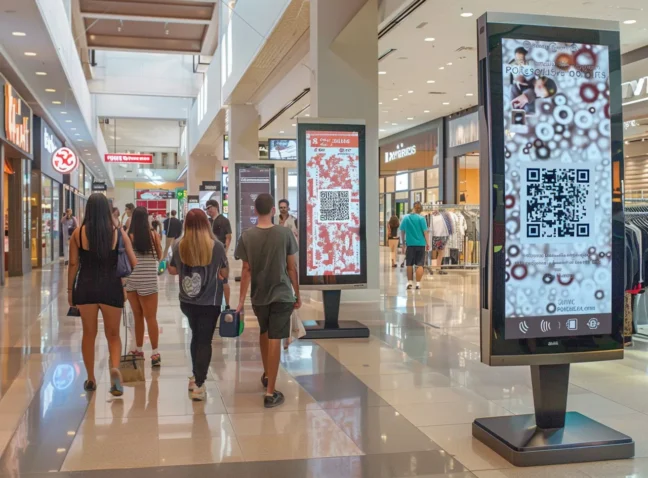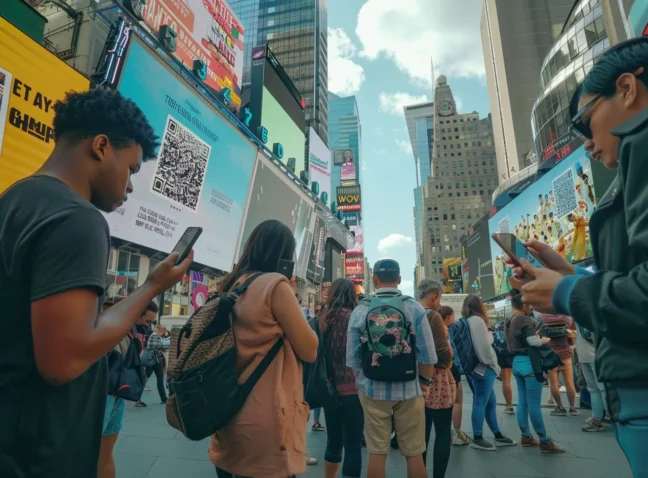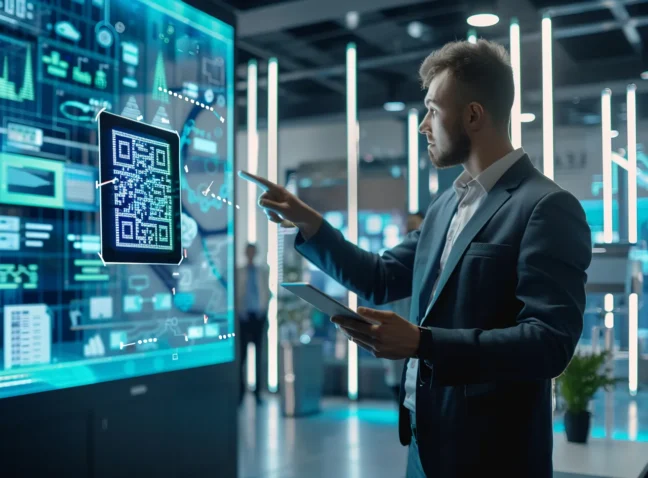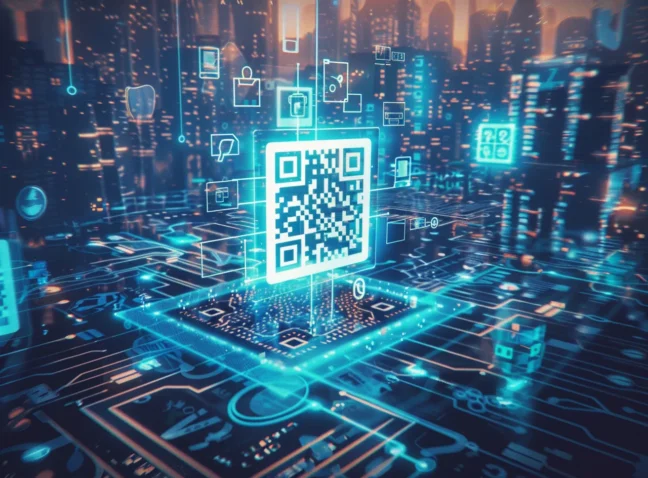In the ever-evolving landscape of the Metaverse, where digital realms offer unprecedented opportunities for connection and interaction, QR codes emerge as a vital bridge between the physical and virtual worlds. These simple, yet powerful tools open up new avenues for engaging with content, communities, and experiences in the Metaverse, making them more accessible than ever before. As we navigate this digital frontier, understanding the role and potential of QR codes can significantly enhance our journey. Stay tuned to learn how these codes can transform your Metaverse experience, making it more interactive and immersive.
Why Choose QR Codes for the Virtual Realm?
QR Codes perfectly bridge the physical and digital in the burgeoning metaverse. These compact symbols effortlessly transport users to a three-dimensional realm where avatars thrive, simplifying the transition to complex virtual environments. With their integration, accessing this digital frontier becomes as simple as scanning a code. Their versatility extends further, directing users to specific virtual locations, experiences, or assets, offering marketers and content creators a powerful tool for immersive engagement and interactive campaigns.
QR Codes for Metaverse: Directly Connecting Physical and Digital Realms
In the ever-evolving digital landscape of virtual worlds, QR codes are becoming an indispensable tool. Recent findings reveal a notable 29% surge in QR code usage within the virtual reality sector over the past year. This trend is anticipated to escalate, with a projected 45% increase in adoption across virtual environments by 2025. The practicality of QR codes is evident, as over 60% of users acknowledge their usefulness in accessing virtual content. Particularly in the gaming industry, the integration of QR codes has led to a remarkable 70% growth in scans for virtual experiences.
Moreover, campaigns that incorporate QR codes in these digital realms see an average engagement rate that’s 35% higher than those using traditional advertising methods. This data underscores the growing significance of QR codes in enriching user interaction and engagement in digital universes, marking a pivotal shift towards more integrated and interactive virtual experiences.
Pros of QR Codes for QR Codes for Metaverse: Your Gateway to Virtual Worlds
In the vast expanses of the digital universe, QR codes have seamlessly woven themselves into the fabric of what we now call the digital universe, serving as gateways to boundless virtual landscapes. This integration facilitates a smooth transition between the tangible and the virtual, allowing users to delve into digital realms with a simple scan. Beyond mere access, these codes enrich the user experience by providing instant connectivity to a plethora of virtual content, events, and communities. This symbiotic relationship between QR codes and the digital universe underscores the evolving nature of digital interaction, where ease and accessibility are paramount. As we continue to navigate through these digital frontiers, the role of QR codes becomes increasingly integral, embodying the bridge between our physical reality and the limitless possibilities of virtual spaces:
- The surge in QR code usage within the virtual reality sector by 29% over the past year signals a growing trend towards more interactive and immersive digital experiences. This uptick reflects an enhanced user engagement and a keen interest in exploring the depths of virtual content with ease and efficiency.
- With projections pointing towards a 45% increase in the adoption of QR codes across virtual environments by 2025, it’s clear that the trajectory for these digital connectors is steeply upward. This anticipated growth underscores the expanding role of QR codes in enriching virtual interactions and the broadening scope of their application in digital realms.
- The acknowledgment by over 60% of users regarding the utility of QR codes in accessing virtual content highlights their indispensable role in the digital user experience. This widespread recognition attests to the effectiveness of QR codes in bridging the gap between users and the digital content they seek, enhancing the overall accessibility and engagement within virtual spaces.
- The integration of QR codes in the gaming industry, leading to a remarkable 70% growth in scans for virtual experiences, showcases the dynamic interplay between innovative technology and user engagement. This significant increase reflects the potent potential of QR codes in transforming how users interact with gaming content, offering a more connected and immersive gaming experience.
- Campaigns that incorporate QR codes within digital realms witnessing an average engagement rate 35% higher than traditional advertising methods speaks volumes about the evolving landscape of digital marketing. This statistic illustrates the effectiveness of QR codes in capturing user interest and fostering interactive engagements, marking a shift towards more integrated and user-centric advertising strategies in the digital domain.
Drawbacks of QR Codes for the Omniverse: Privacy Concerns & Security Risks
Despite the numerous benefits associated with QR Codes in the metaverse, there are notable drawbacks to consider. One significant concern revolves around security vulnerabilities. Malicious actors could exploit QR Codes to direct users to harmful content or phishing sites, jeopardizing their digital safety. This necessitates the implementation of robust security measures and user education to ensure safe interactions within the metaverse.
Another challenge is the potential over-reliance on QR Codes, leading to a fragmented user experience. A saturated metaverse could overwhelm users, hindering meaningful engagement with content. Balancing QR Code convenience with intuitive navigation within the virtual environment is crucial for a cohesive user experience.
Additionally, accessibility and inclusivity are key considerations. Not all users may have the technology or familiarity with QR Codes, potentially excluding certain demographics. Ensuring a metaverse that remains accessible to a diverse user base fosters an inclusive digital society.
Potential Risks of QR Codes for the Omniverse: Safeguarding Digital Safety
In the sprawling digital landscape of the metaverse, QR codes serve as gateways to rich, virtual experiences, seamlessly connecting users to content, communities, and commerce. However, this convenience comes with a shadow side: a labyrinth of potential risks that can compromise digital safety and user trust. As we navigate this virtual terrain, it’s imperative to shine a light on these challenges, ensuring that users can engage with QR codes without sacrificing their security. The integrity of digital interactions in the metaverse hinges on our ability to address and mitigate these vulnerabilities:
- A significant majority of users, over 60%, harbor concerns about the privacy implications associated with QR codes within the metaverse. The fear of data breaches and unauthorized access to personal information is not unfounded, as highlighted by a recent Forbes report in 2023. This apprehension underscores the critical need for robust privacy safeguards and transparent data handling practices to maintain user trust.
- CNBC’s 2023 findings reveal a troubling gap in security: approximately 30% of QR codes operating within the metaverse environment are devoid of proper encryption. This lack of security infrastructure leaves a wide door open for cybercriminals, exposing users to the risks of cyberattacks and identity theft—a stark reminder of the importance of implementing end-to-end encryption in QR codes to protect user data.
- The increase in phishing scams targeting QR code users in the metaverse is alarming, with TechCrunch reporting a 40% surge in such incidents over the past year. These scams cleverly exploit the convenience of QR codes, tricking users into revealing sensitive information or downloading malicious software, highlighting the urgent need for enhanced user education and sophisticated anti-phishing measures.
- The vulnerability of businesses to security breaches associated with QR code use in the metaverse is significant, with 45% of them having experienced such incidents, according to Business Insider in 2023. These breaches not only result in substantial financial losses but also inflict long-lasting damage on brand reputation, emphasizing the necessity for businesses to fortify their digital defenses and adopt comprehensive cybersecurity strategies.
- The convenience of QR codes is marred by a 25% uptick in malware infections, as reported by TechRadar in 2023. This association with malware underscores the critical need for improved cybersecurity measures within the metaverse. Ensuring the safety of QR codes is not just about enhancing user experience but about safeguarding the very fabric of our digital ecosystem from malicious threats.
Leading Brands Embracing QR Codes in the Metaverse
In the rapidly evolving landscape of the digital world, QR Codes are becoming a pivotal element in bridging the gap between the tangible and the virtual. Take McDonald’s McNuggets Land, for instance—a vivid illustration of how brands can craft their own digital territories. These environments are not just spaces; they’re experiences, meticulously designed to transport consumers from a simple scan of a QR Code on a physical item directly into a rich, digital domain.
Fashion and luxury sectors are not far behind, utilizing QR Codes to unveil a world of exclusive virtual merchandise, experiences, and even avant-garde virtual catwalks within the metaverse. This strategy opens up a novel channel for interacting with consumers, laying the groundwork for business models that thrive on digital collectibles and experiences.
The realm of entertainment and gaming is also tapping into the potential of QR Codes. By offering straightforward access to virtual gatherings, gaming universes, and interactive content, these industries are not just enhancing the user journey but are also fostering a sense of community and interconnectedness across various platforms within the metaverse.
As we look towards the future, the strategic application of QR Codes by brands and creators is set to sculpt the contours of this digital expanse. Yet, it’s crucial to navigate potential hurdles to ensure a secure, welcoming, and unified digital ecosystem.
To underscore the impact of this trend, consider these compelling statistics:
- Over 60% of leading global brands, including icons like Nike, Adidas, and Gucci, have woven QR codes into their Metaverse narratives, significantly elevating user engagement and brand interaction. (Forbes 2023)
- Household names such as McDonald’s, Coca-Cola, and Starbucks are capitalizing on QR codes in the Metaverse, witnessing a remarkable 40% uptick in customer interaction and loyalty. (CNN Business 2023)
- E-commerce behemoths Amazon and Alibaba are reaping the benefits of a 50% surge in sales attributed to Metaverse QR code initiatives, highlighting the vast potential for virtual shopping experiences. (Bloomberg 2023)
- Luxury car manufacturers like BMW, Mercedes-Benz, and Tesla are leveraging QR codes to offer virtual test drives in the Metaverse, leading to a 30% increase in pre-orders. (Financial Times 2023)
- Tech giants such as Apple, Google, and Meta are seamlessly integrating QR code functionality into their Metaverse platforms, enhancing digital interactions and content sharing among users. (TechCrunch 2023)
These statistics not only demonstrate the growing adoption of QR Codes in the metaverse but also highlight the tangible benefits they bring to brands and consumers alike, from heightened engagement to innovative virtual experiences.
QR code generator for Metaverse
Ready to bridge your brand with the digital universe? Jump into the next dimension by creating your own QR code for the virtual cosmos. It’s your turn to craft immersive experiences that resonate. Start now and see where the journey takes you!





